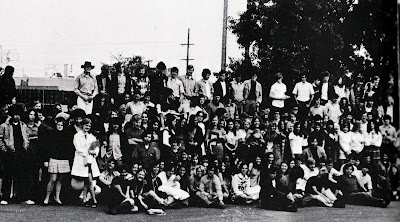
The big news around these parts is that University of Oregon President Richard Lariviere has been fired "without cause" by the state Board of Higher Education and -- for all intents and purposes -- Governor John Kitzhaber in a major showing of no confidence.
The day after Thanksgiving, with nary an attempt at transparency, the board scheduled a meeting on Monday, November 28 to discuss the apparently predetermined "finis" of the popular Lariviere. The tactic was an ingenuous ruse at best, and a public relations disaster for state government at worst. Campus was closed on Friday and most associated with UO were enjoying the four-day weekend.
When news surfaced about the Monday meeting in Portland, the antennae of conspiracy immediately sprouted on the UO campus. My UO email in-box overflowed with outraged yet well-reasoned prose opposing his termination by members of the greater UO community.

Calls to retain the UO president and disband the board reverberated around the campus. Saddled with a barrage of digital communication, it was hard for me to discern the desperate pleas of mercy from students seeking an extended deadline on an assignment.
Shocked like many others in the UO community, it wasn't a question of whether I had a dog in this fight, but how many.

As a UO alum, I've observed with heightened concern over the diminishing state support for higher education over the past 30 years. The State of Oregon now provides less than 7 percent of the funding for the University of Oregon. It's hard to maintain "excellence" when the fiscal noose continues to tighten, squeezing the life out of my alma mater like a python strangling its prey.
Yet despite continued reductions in state support, the UO has survived and -- indeed -- thrived, thanks in part to Lariviere. Enrollment and fundraising are at an all-time high, and Lariviere has a vision and a talent for inspiring others on campus to strive for an even better University of Oregon.
As a longstanding part-time employee of the University of Oregon, I've seen talented faculty recruited by other, more well heeled universities because of below market compensation policies, particularly when compared to faculty at other public institutions. Quality of life only takes you so far. Lariviere knows this and recently awarded $5 million in pay raises to 1,300 UO faculty and staff.
As a consumer who has helped put his kids through UO, I've witnessed increasing tuition rates to help compensate for the loss of funding from the state. Backed into a corner, the UO has established a business model that utilizes out-of-state and international student tuition rates to balance the budget. In-state tuition is less but continues to rise faster than the consumer price index.
The University of Oregon currently receives less money from the state per capita than any other public university in Oregon.

It's not a pretty picture, and no matter how you slice it, the state has withdrawn its investment in higher education.
Lariviere's "New Partnership" initiative sought to address the shortfall and bring greater financial autonomy to the UO.
My personal experience with UO President Richard Lariviere is strictly anecdotal, though he has impressed me as someone I would want on my team. The first time I met the man was on my path to school one morning. Passing him on my way to Allen Hall, he tipped his ever-present fedora and smiled: "good morning." As a humble adjunct faculty member at the UO SOJC, I was immediately impressed.
My next encounter was the result of an impromptu photo shoot during the parade last January to honor the Ducks for their stellar football season. I shot a number of pix and posted them on Facebook; his wife, Jan Lariviere, spotted one of my images of her husband and asked to be my "friend" on the social networking site. Later, Richard himself would "friend" me (has "friend" become a verb?)
When Lariviere was informed that his contract would not be renewed, he sent all faculty, staff and students an email: "I received news on Monday in a meeting with the chair of the state Board of Higher Education that my contract at the University of Oregon will not be renewed. I was told that I could resigned or accept the termination of my contract (in July, 2012). I am weighing those options at this time."

Clearly, he had irked the board, an antiquated and ineffectual -- and in this case draconian -- body of volunteers, as well as Governor John Kitzhaber, for "not being a team player" and for pursuing his own agenda of a more independent University of Oregon.
Unfortunately for the board, its back-alley effort to terminate Lariviere over the Thanksgiving holiday weekend backfired. The local community and many others rallied behind Richard Lariviere with a grassroots "We Stand With The Hat" campaign in an attempt to force the board to retain the UO president.
A rally and teach-in was scheduled for Monday on campus, and support for the president was pervasive at the annual Civil War football game between Oregon and Oregon State at Autzen Stadium on Saturday, November 26. UO alum and Nike founder Phil Knight likened the board's impending action against Lariviere as a "bad decision" that seemed to resemble an "application of Oregon's assisted suicide law."
On Monday, a large contingent of UO faculty, alumni and students packed the room at Portland State University in a two-hour public meeting that can only be described as testy, volatile and emotionally wrought. "It was quite warm in that room, over 100 degrees," noted eyewitness Loren Ruark, a KVAL-TV cameraman and friend who observed the resulting fireworks. He may have been only mildly exaggerating about the temperature: "it was hot," he added.

The efforts of supporters would not be enough; the state Board of Higher Education fired Lariviere for "frayed relationships" and "broken trust." Response was instantaneous and harsh: board members were met with jeers and boos as they attempted to explain their positions.
If anything, the abrupt dismissal of Richard Lariviere has only fanned the flames of efforts to support the UO's quest to survive.
And, in a case of 20-20 hindsight that can only be described as a "make up call" in sports parlance, the board has appointed Lariviere's part time assistant Robert Berdahl -- a former University of Oregon professor and dean -- as interim president, a clear showing of deference to the greater UO community.
As for Lariviere, stay tuned. As a tenured professor in Sanskrit, we may continue to see "the hat" on campus for some time to come.

 This season, the Ducks lost their opener to perennial power Louisiana State University (this year's #1), sustaining minimal damage to their hopes for another BCS berth, thanks to a respectable defeat to a highly ranked team from the SEC.
This season, the Ducks lost their opener to perennial power Louisiana State University (this year's #1), sustaining minimal damage to their hopes for another BCS berth, thanks to a respectable defeat to a highly ranked team from the SEC. As a longtime season ticket holder, I was able to secure two seats for the pageant in Pasadena (right) for my Dad, Ralph Mitchell, and his wife Florence. They will attend the game on their way back to Sun Lakes, Arizona for the winter.
As a longtime season ticket holder, I was able to secure two seats for the pageant in Pasadena (right) for my Dad, Ralph Mitchell, and his wife Florence. They will attend the game on their way back to Sun Lakes, Arizona for the winter. "How to use the Duck deity: 1) fill with whiskey; 2) rub head; 3) pray for turnovers; 4) drink contents; 5) proceed to game; 6) repeat #1 and #4 if losing in the third quarter." The best-case scenario? I won't need to repeat any steps, of course. Go Ducks!
"How to use the Duck deity: 1) fill with whiskey; 2) rub head; 3) pray for turnovers; 4) drink contents; 5) proceed to game; 6) repeat #1 and #4 if losing in the third quarter." The best-case scenario? I won't need to repeat any steps, of course. Go Ducks! As a longtime season ticket holder, I was able to secure two seats for the pageant in Pasadena (right) for my Dad, Ralph Mitchell, and his wife Florence. They will attend the game on their way back to Sun Lakes, Arizona for the winter.
As a longtime season ticket holder, I was able to secure two seats for the pageant in Pasadena (right) for my Dad, Ralph Mitchell, and his wife Florence. They will attend the game on their way back to Sun Lakes, Arizona for the winter. "How to use the Duck deity: 1) fill with whiskey; 2) rub head; 3) pray for turnovers; 4) drink contents; 5) proceed to game; 6) repeat #1 and #4 if losing in the third quarter." The best-case scenario? I won't need to repeat any steps, of course. Go Ducks!
"How to use the Duck deity: 1) fill with whiskey; 2) rub head; 3) pray for turnovers; 4) drink contents; 5) proceed to game; 6) repeat #1 and #4 if losing in the third quarter." The best-case scenario? I won't need to repeat any steps, of course. Go Ducks!
















































